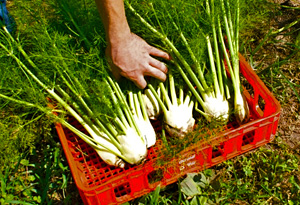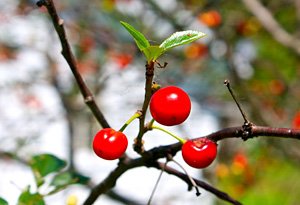Food Is Love

Photo: Rick Martin
This is it. Right now. Simran Sethi says this is the time to get to a farmer's market and savor the tastes of the summer. Don't squander it.
This is the season when fragrant peaches yield to the touch, carrots don't look anemic, and tomatoes taste like tomatoes. You know what I'm talking about. Tomatoes: sweet, tender, juicy; not the mealy, flesh-colored objects that masquerade as tomatoes in the dead of winter, shipped from miles and miles away. No, tomatoes that are only available when the season allows it—the ones that couldn't weather the 1,700-mile journey that the average food item on a North American plate travels from farm to fork.There is something sacred in the taste of an organic heirloom tomato. It is something a long-distance tomato—bred not for taste but endurance to be shipped without bruising—just can't possess. There is something precious about eating a fruit grown close to home, in season. It doesn't just taste better; it's also better for you. Plants lose nutritional value when they're pulled off the vine before they're ready. Travel-friendly but underripe, they mature on a ship or truck instead of under the sun.
What's more, there is something sacred about the hands that grew that tomato, the hands that feed us all. Yet the awareness of who grows our food and how they grow it is rarely front and center. Small and midsize farms have been on the decline for decades, unable to compete with the economies of scale that larger agribusinesses can offer. Transportation costs and additional farm expenses for petroleum-based fertilizers and pesticides have risen, while the amount of money going back to farmers has remained stagnant for more than a decade. According to the USDA, about 20 cents for every food dollar we spend goes back to the farmers.
Considering these numbers, it should come as no surprise that, in the past five years, roughly 80,000 midsize farming operations have disappeared.

Photo: Rick Martin
There is a deeply delicious and satisfying way to try to increase these numbers: Buy food directly from local farmers. I was reminded of this at a farm dinner hosted by Free State Brewing Company. The five-course dinner was held at Prairie Star Farm—a sweet spot of land in De Soto, Kansas, ripe with raspberries, cherries, garlic, greens and flowers—and paired incredible local food with handcrafted beers enhanced with wheat, berries and lemongrass from the farm. The distance between the farm and our forks disappeared. My gratitude grew exponentially for these farmers, sitting just a few feet away from me, and for their efforts that went into feeding me.
This meal was the manifested vision of Free State's executive chef Rick Martin, a new friend and constant source of inspiration. Before the dinner started, I asked Rick what I really needed to save myself for. I'm 5 feet tall, weigh 95 pounds and knew I couldn't fully imbibe six beers and five plates of food. "The soup," he said. "The cold cherry soup."
I can't fully describe how deeply nourishing the meal was, but I suspect you've experienced something similar: the sensation you get when you eat something borne out of love—a meal prepared by someone who cares about you and cares about the food, a meal that feeds your body and soul. The soup was made with sour cherries fresh from the farm, a family recipe passed down from Prairie Star proprietress Margit Hall (who runs the farm with her husband, Bart) as part of a dinner that, for years, had been Rick's dream. The care was undeniable, and the soup was delectable.
Get the recipe for Margit Hall's Tart Cherry Soup.
Most of my meals are not so expertly prepared. My staples are bread, hummus and salad, or organic mac and cheese blended with fresh spinach and tomatoes. I frequent my natural food coop but usually struggle to make it to the farmer's market before it closes on Saturday mornings. But this meal shifted something in me. It made me slow down and recommit to seeking out my farmers. It reminded me how lucky I am to have such dedicated growers in my community and why I don't want to lose them to corporate agriculture.
So I am channeling my inner Jamie Oliver and starting my personal food revolution. Right now. If you feel the same way, join me. Get to a farmer's market. Invest in a farm by supporting community-supported agriculture (CSAs). Start a garden at your child's school or in your own backyard. Grow food, not grass. Find out what grows in your area and when it's in season—and then buy it or grow it yourself.
Encourage your favorite restaurant and favorite grocery to offer more local items from farms in your area. Volunteer at a food bank. Support an urban farm. If you're an omnivore, celebrate those who hunt for food, not sport.
Or, just eat a really good meal, away from the television, slowly, with friends. Give thanks for the hands that helped get that meal to you. Give thanks for your full belly. If you're lucky, pick cherries and make soup.
Bon appetit,
Simran
P.S. The way to this woman's heart is through her stomach. Follow my food and ag tweets on Twitter @simransethi.
Simran Sethi is an award-winning journalist and associate professor at the University of Kansas School of Journalism and Mass Communications. For more information on Sethi, visit SimranSethi.com and follow her on Twitter @simransethi.
Keep Reading:
What kind of gardener are you? Take this Oprah.com quiz
You grow girl! Urban gardening made simple
Author Michael Pollan's 5 food rules to live by
This meal was the manifested vision of Free State's executive chef Rick Martin, a new friend and constant source of inspiration. Before the dinner started, I asked Rick what I really needed to save myself for. I'm 5 feet tall, weigh 95 pounds and knew I couldn't fully imbibe six beers and five plates of food. "The soup," he said. "The cold cherry soup."
I can't fully describe how deeply nourishing the meal was, but I suspect you've experienced something similar: the sensation you get when you eat something borne out of love—a meal prepared by someone who cares about you and cares about the food, a meal that feeds your body and soul. The soup was made with sour cherries fresh from the farm, a family recipe passed down from Prairie Star proprietress Margit Hall (who runs the farm with her husband, Bart) as part of a dinner that, for years, had been Rick's dream. The care was undeniable, and the soup was delectable.
Get the recipe for Margit Hall's Tart Cherry Soup.
Most of my meals are not so expertly prepared. My staples are bread, hummus and salad, or organic mac and cheese blended with fresh spinach and tomatoes. I frequent my natural food coop but usually struggle to make it to the farmer's market before it closes on Saturday mornings. But this meal shifted something in me. It made me slow down and recommit to seeking out my farmers. It reminded me how lucky I am to have such dedicated growers in my community and why I don't want to lose them to corporate agriculture.
So I am channeling my inner Jamie Oliver and starting my personal food revolution. Right now. If you feel the same way, join me. Get to a farmer's market. Invest in a farm by supporting community-supported agriculture (CSAs). Start a garden at your child's school or in your own backyard. Grow food, not grass. Find out what grows in your area and when it's in season—and then buy it or grow it yourself.
Encourage your favorite restaurant and favorite grocery to offer more local items from farms in your area. Volunteer at a food bank. Support an urban farm. If you're an omnivore, celebrate those who hunt for food, not sport.
Or, just eat a really good meal, away from the television, slowly, with friends. Give thanks for the hands that helped get that meal to you. Give thanks for your full belly. If you're lucky, pick cherries and make soup.
Bon appetit,
Simran
P.S. The way to this woman's heart is through her stomach. Follow my food and ag tweets on Twitter @simransethi.
Simran Sethi is an award-winning journalist and associate professor at the University of Kansas School of Journalism and Mass Communications. For more information on Sethi, visit SimranSethi.com and follow her on Twitter @simransethi.
Keep Reading:
What kind of gardener are you? Take this Oprah.com quiz
You grow girl! Urban gardening made simple
Author Michael Pollan's 5 food rules to live by



